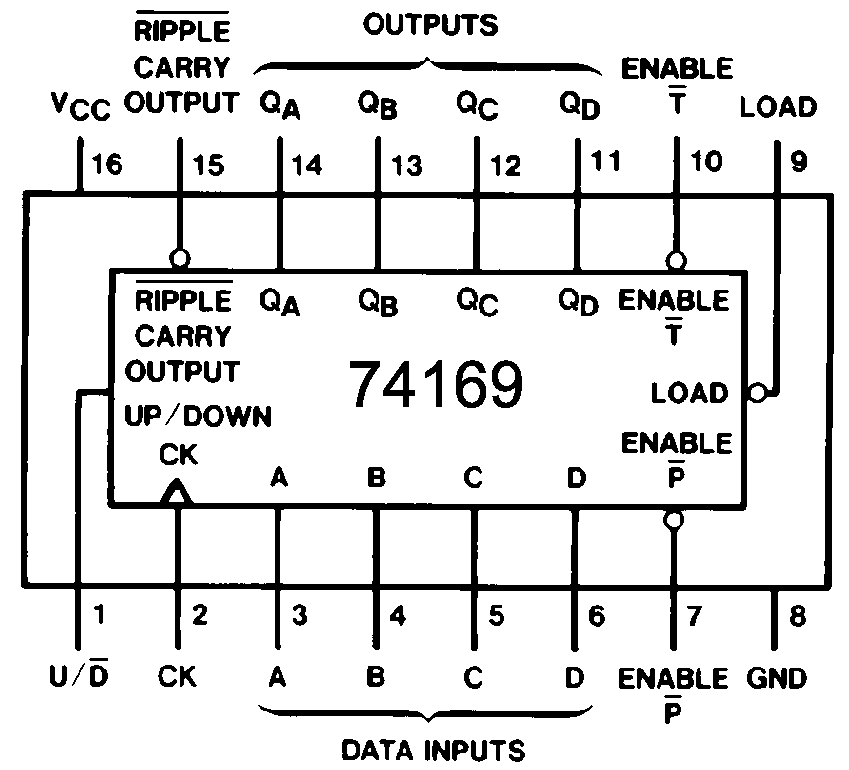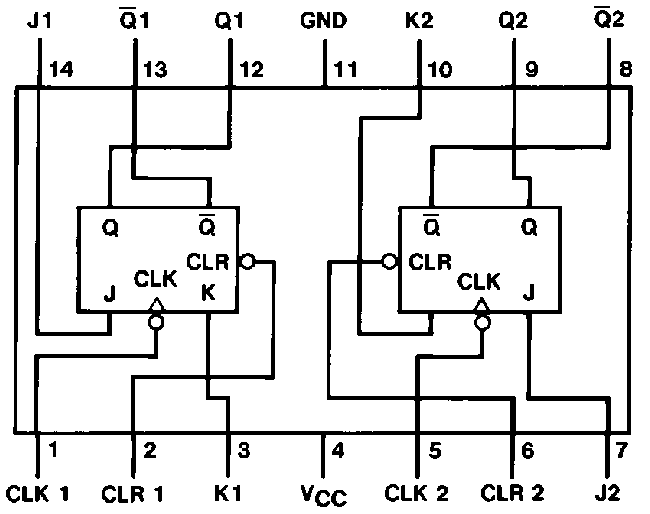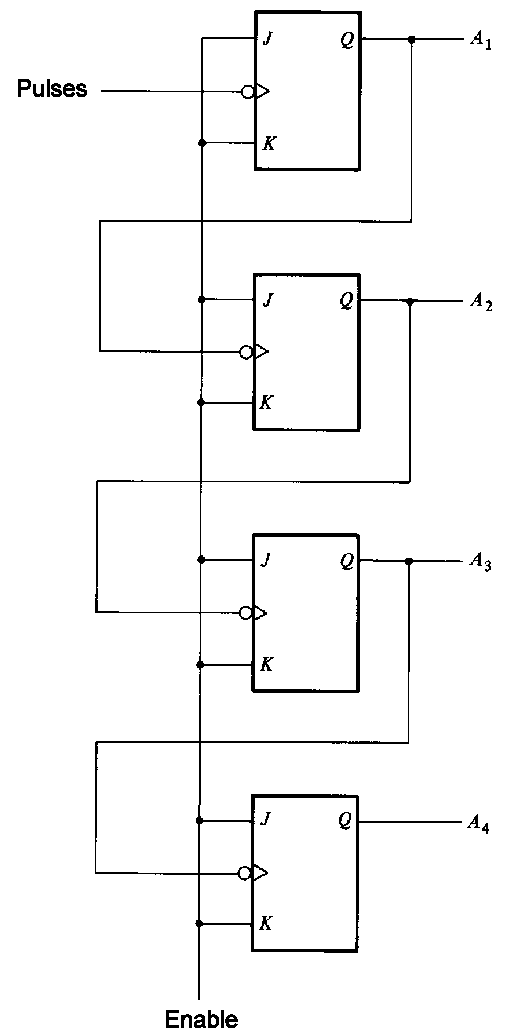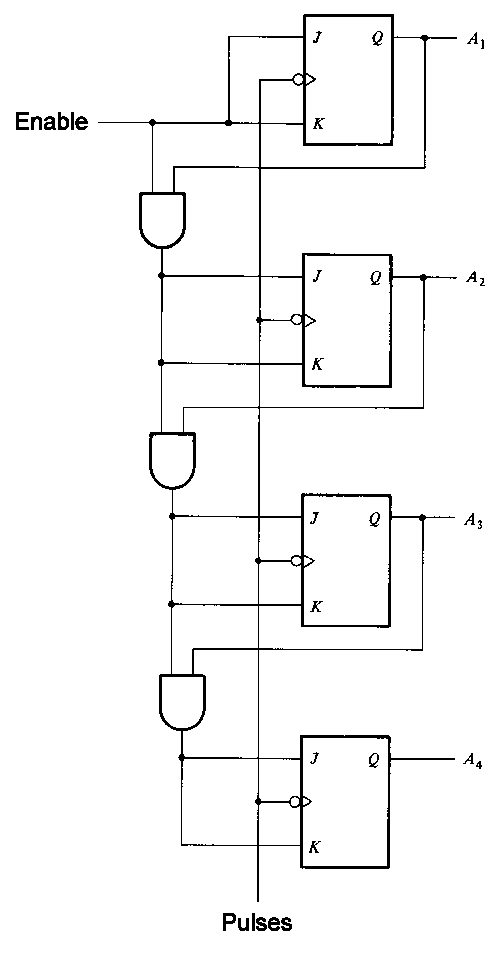
Dangerous line voltages are present at the outlets on your work bench. Do not inert anything other than approved power plugs into these outlets.
The voltages and currents produced by the Digi Designer are generally safe. However, you should not short +5V (Vcc) or logic High outputs directly to ground or intentionally make yourself part of a logic circuit.
Chip pins and the tips of the small wires may be sharp. Handle with care. Chips can become very hot if wired incorrectly. Be careful.
 |
| Figure 1 -- Pin outs for the 74169 up/down binary counter chip. |
Insert your 74169 into the bread board on your Digi Designer. Connect power and ground to pins 16 and 8, respectively. Set the Digi Designer clock to 1 Hz. Make the following connections from left to right across the lower edge of the chip:
| Pin | Function | Connection |
|---|---|---|
| 1 | U/D' (up/not down) input | J20, normally high pulser |
| 2 | Ck (clock) input | J14, clock |
| 3 | A input | J18, switch |
| 4 | B input | J17, switch |
| 5 | C input | J16, switch |
| 6 | D input | J15, switch |
| 7 | P' (active low enable) input | Ground, logic False |
Make the following connections from right to left across the upper edge of the chip:
| Pin | Function | Connection |
|---|---|---|
| 9 | Load (active low) input | J22, normally high pulser |
| 10 | T' (active low enable) input | Ground, logic False |
| 11 | QD output | J1, lamp monitor |
| 12 | QC output | J2, lamp monitor |
| 13 | QB output | J3, lamp monitor |
| 14 | QA output | J4, lamp monitor |
| 15 | Ripple Carry (active low) output | No connection |
Test your circuit and complete the table in the attached work sheet. It should normally count up in binary. Holding pulser button S7 down should cause it to count down. Pressing pulser button S8 should cause whatever value is set by switches S3 through S6 to be loaded into the counter. Releasing pulser button S8 should then re-enable counting from the loaded value.
In the next two exercises you will use 7473 dual JK flip-flop chips. The pin outs for the 7473's are shown in Figure 2. Note the unusual locations for the power and ground connections (pins 4 and 11, respectively) on this chip.
 |
| Figure 2 -- Pin outs for the 7473 dual JK flip-flop chip. |
Build the 4-bit binary ripple counter circuit shown in Figure 3. Use two 7473 dual JK flip-flop chips to build this circuit. Connect all the CLR (asynchronous clear) flip-flop inputs together and connect them to one of the normally high pulser outputs on your Digi Designer. Use one of the Digi Designer switches for the Enable input and use the Digi Designer clock (set at 1 Hz) as the Pulses source. Connect the counter outputs A1 through A4 to lamp monitors J4 through J1, respectively. Test your counter and record the results on the attached work sheet.
 |
| Figure 3 -- Use two 7473 chips to provide the 4 JK flip-flops needed for this 4-bit ripple counter circuit. |
Build the 4-bit binary synchronous counter circuit shown in Figure 4. Use two 7473 dual JK flip-flop chip and one 7408 quad AND chip. Connect all the CLR (asynchronous clear) flip-flop inputs together and connect them to one of the normally high pulser outputs on your Digi Designer. Use one of the Digi Designer switches for the Enable input and use the Digi Designer clock (set at 1 Hz) as the Pulses source. Connect the counter outputs A1 through A4 to lamp monitors J4 through J1, respectively. Test your counter and record the results on the attached work sheet.
 |
| Figure 4 -- Use two 7473 chips and a 7408 chip to build this 4-bit synchronous counter. |
Chip pin out diagrams in this document were taken from Fairchild/National Instruments chip data sheets. Figures 3 and 4 were taken from Digital Design, 2nd ed. by M. Morris Mano.